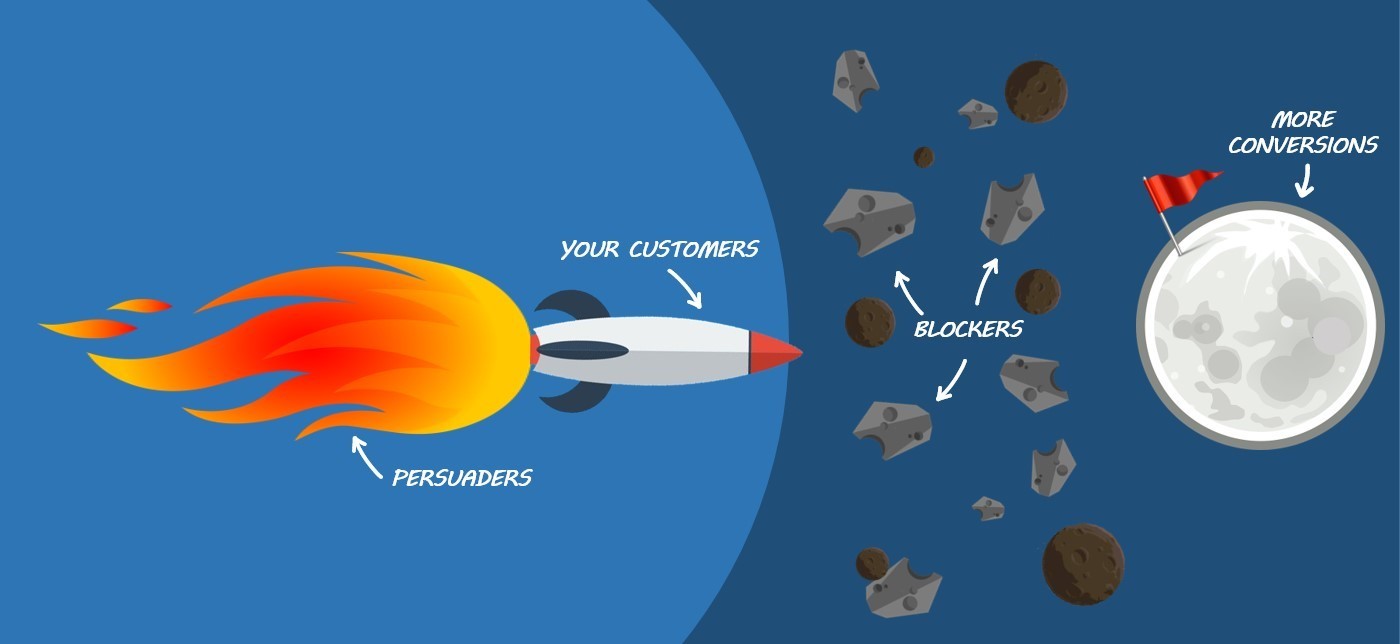Blockers and Persuaders – The Simple Key To Conversion Success
Conversion Rate Optimisation, or CRO, is about improving the conversion performance of a website, app or campaign. Conversions can be financial (in the case of ecommerce websites) or non-financial (e.g. people completing contact forms on a website).
There are many different ways to identify areas to focus your CRO efforts on, one particular method, which we often use at Fresh Egg, is to look for conversion ‘blockers’ and ‘persuaders’.
What are blockers and persuaders?
This post will give you the ammunition to exploit the most common conversion opportunities by showing you 10 of the most critical blockers and 10 of the most powerful persuaders
Getting prospective customers to take a desired action, regardless of the situation, comes down to a very simple equation - if the sum of their motivations is greater than the sum of their blockers then they will take action, if the sum of their blockers is greater than the sum of their motivations, they will not.
Every decision we make, every day of our lives, is based on the above equation. If we’re wondering whether or not to cross a road, in a split second we will weigh up the benefits of getting to the other side against the effort needed and risks involved. All it takes is the balance to be slightly on one side of the scales to dictate which course of action we choose.

If we use the analogy of your business website being a rocket in space with the destination being the moon (goal); blockers are like the meteorites in the way that slow your rocket down and prevent your traffic from converting, where they otherwise would’ve done.
Persuaders are like the fuel that drives your business forward - these are areas that motivate users to become customers who otherwise may not have converted. The more persuaders you have, the faster you'll reach the moon (your goals).
To enable your business rocket to reach the moon in the most efficient manner, you should look to remove all the blockers and have as many persuaders as possible to drive your business forward. This is the approach we take in CRO at Fresh Egg.
This blog post presents 10 common examples of blockers and persuaders in a bid to highlight some of the key factors you should be considering when planning a CRO.
Blockers
Blockers are features on a website that put people off converting. There are many different types of blockers but ten of the most common are covered below.
1. Slow loading time

We’ve all been frustrated by slow loading websites. A delay in load time of just one second can lead to a 7% decrease in conversions, so slow sites can have a huge impact on conversion rates. With competitor websites only as click away it’s vital that a website loads quickly so as not to keep the user waiting.
2. Perceived high price

The price of a product will naturally be a major deciding factor in whether users decide to purchase it or not - reasons why retail sales drive more sales volumes. Customers expect to pay premium prices for premium products but it can be challenging to get across the quality of a product online. Online they won’t be able to feel or use products so clear photos, descriptive benefits and positive reviews are essential in prevent a high price from becoming a blocker.
3. Abundance of choice
Giving people a lot of choice is often seen as a positive thing. However, giving people too much choice can cause them problems - people are actually more likely to make a purchase when offered only a limited number of choices in some instances.
This is also the case for navigation where giving too many options can cause choice paralysis, leading users to leave a website rather than picking one of a high number of options.
4. Poor usability

Usability is a way of describing how easy it is to use a ‘human made object’ such as a website or product. If a website is difficult to use then people will look elsewhere for an easier alternative. One of the best ways to uncover usability issues is to run usability testing on your website.
5. Distractions

Users are exposed to all manner of distractions when online. These include multiple notifications from apps, intrusive advertising and overly busy pages. To maximise your conversions you should keep any distractions on your website to an absolute minimum.
Keeping product pages simple and ensuring a clear pathway to converting are crucial. A good example of removing a distracting blocker is removing navigation from checkouts. This can have a very positive impact on conversions.
6. Information overload

The amount of information on a page will have a big impact on conversion rates. It has often been claimed that people don’t read online and studies have shown that on average users read as little as 20% of the content of a page. As well as minimising the amount of copy, webpages should be laid out in a way that makes the content easily scannable, so that users can quickly find what they are looking for.
7. Lack of clarity

Clarity of the product or service offering is a crucial factor in convincing users to convert. Put simply, if they are unsure what they are buying then they’re going to be unlikely to buy it!
Jargon should normally be avoided as users are unlikely to take the time to look up meanings of unfamiliar words. The one exception here is if you are communication with an audience who you know will be familiar with the terminology that you use. Unique selling propositions (USPs) are also vital here to ensure that benefits are clear to users and validate as to why they should buy your product and not your competitors.
8. Lack of trust

People today are more open about purchasing online than they were in past times, but security is still a big issue, particularly for mobile users. Recent studies have shown that around 80 percent of consumers still experience some sort of hesitancy when purchasing goods on mobile.
Trust is not only a factor for ecommerce sites though. It is vital for any website, particularly when users encounter a business for the first time online. Displaying industry accreditations, awards, security certificates and including social proof are all excellent ways to help to gain a users’ trust.
9. Moral/ethical issues

There has been a rise in ethical consumerism. According to studies, a third of UK consumers claim to be concerned about the ethical nature of the origin of the products that they buy. While it may be hard to change a consumer's perception though your website, demonstrating that your products are ethically produced and sourced may remove this particular barrier.
10. Compatibility problems

A whole range of compatibility issues can affect your conversion rates. Technical issues, like your website not working in particular browsers, or not appearing correctly on particular devices can be a major cause of frustration to users. The payment methods that you accept can also be a big blocker. An example of this is PayPal, which now has over 184 million active accounts! This is a huge customer base who may be ‘blocked’ from buying if they are unable to use this payment service on your website.
Persuaders
Persuaders are features on a website, or elsewhere, that can convince people to convert when they may otherwise not have intended to. As with blockers there are many different types of persuaders, but we’ve covered ten of the most common ones below.
1. Social proof

What other people think of a product plays a big part in whether users go on to purchase it. Social proof takes many forms including reviews, ratings, testimonials and social media likes, shares and comments. Studies have shown that 61% of customers read online reviews before making a purchase decision, so reviews and ratings are likely to have an impact on the majority of your users. Testimonials can be very powerful too, in this example including testimonials led to a 34% increase in sales.
2. Power of reciprocity

In psychology, reciprocity is a social rule that suggests people will repay a good deed that another person has done for them.Studies have found that people like to give back. In the online environment, this principal of reciprocity can be used in an exchange of personal information, such as providing the user with a free eBook if they submit their email to a subscription.
3. Likeable features

Being a ‘likeable’ brand is a good way to help persuade people to buy from you. Marketing teams spend a lot of time and effort in making sure that their brand has a personality, and this can show great results if it’s replicated across a website.
4. Authority

Showing you’re an expert in your field is another strong persuasion technique. This can be achieved by publishing regular blog posts about your area or expertise and by winning awards and gaining accreditations to prove you’re a thought leader in your industry. If you can prove your authority then this will help to build trust in your brand. Being well-connected and credible is also of importance.
5. Scarcity and urgency

Scarcity and urgency can be used to encourage users to buy quickly. Scarcity messaging, such as telling users that items are low in stock will help encourage them to buy now, rather than putting it off until later. Limited time deals, such as flash sales, will create urgency and can also lead to increased conversions as a result.
6. Anchoring

In the same way that price can be seen as a blocker, a perceived bargain can send out a strong persuasive message. Showing that an item is half its normal price, or cheaper than being offered by competitors, can help increase sales. The technique of anchoring describes how users focussing heavily on a particular price point so that prices become relative to that rather than relative to the real value of a product.
7. Benefit driven language
It’s tempting to tell your website visitors how great your product is, but it’s more valuable to show them the benefits that they will experience from using the product. Your users may not be impressed by features, but they will be able to relate to how the product will improve their lives!
8. Micro commitments

James Tuckerman, founder of Anthill Online and Not So Freaky University famously said: “You wouldn’t ask someone to marry you before you’ve shared a cup of coffee with them.” This little anecdote is a good representation of how to work with a customer - by starting off with small steps and then proceeding to a bigger commitment purchases.
This applies to your website - but getting your users to follow through on a series of micro-commitments will appear less daunting than the big final commitment. For example, a website that allows users to socially share the fact they’ve started a free trial of a product is more likely to encourage those users to commit to buying the product after the trial.
9. Consistency

When a user is searching for a solution and sees your advertisement matches their need, upon clicking it, they have the expectation to be lead to a relevant page. Consistency is especially relevant when creating a landing page to complement an AdWords campaign. Users will determine relevancy by looking for consistent navigation, branding, messaging and style. Using strong consistent messaging across all mediums will lead to a seamless user experience.
People have a preference to consistency in others, they also strive to be consistent themselves as this is viewed as a good character trait. This makes them more likely to follow through on the micro- commitments they make, as described in point number 8.
10. Reassurance

Users may have doubts about a purchase, particularly if it’s an expensive one. To help them get past this reassurance is vital. This can be helped by other persuasion methods (e.g. social proof), though the copy on your site should also incorporate reassuring messaging. This is true even for pages that the user sees after making a purchase. Humans don’t trust machines so additional reassurance is required by people buying online.
Next steps
There are several different aspects that should be considered when looking to improve the user experience of your website. Breaking these down into blockers and persuaders will help you focus on two key areas and ensure that your website is easy to use. The combined power of the techniques mentioned in this post will transform the conversion potential of your website, app or marketing material.
Of course, it's important to learn how each applies to your specific target audience. Try focusing on one blocker or persuader at a time to see how your customers react to changes. This can be achieved by A/B testing your ideas or by surveying customers for their opinions.
It is important to remove as many blockers as possible and to tip the balance in favour of persuasion to turn those non-converters into paying customers.
Contact our conversion services team to find out how we can help you add persuasion to and remove blockers from your website.